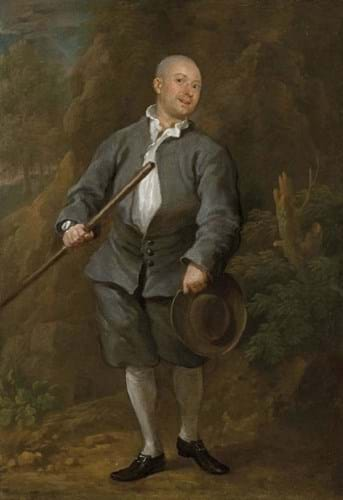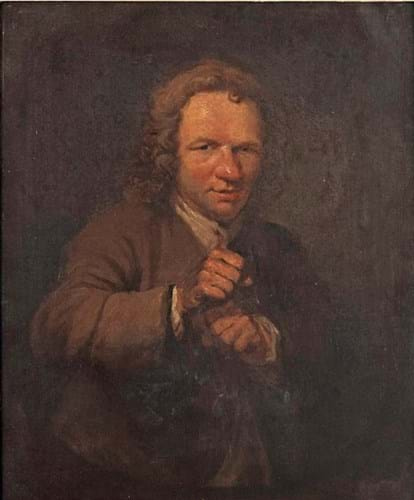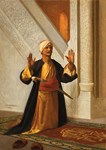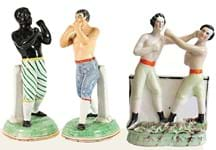When dealer Pierre Spake spotted a painting of a pugilist coming up at a London auction catalogued as ‘possibly John [Jack] Slack’ it immediately caught his attention.
Slack, also known as the ‘Norfolk Butcher’ or ‘Knight of the Cleaver’ was a bare-knuckle fighter who won what is regarded by some as the first ‘international’ heavyweight fight, in 1754.
And Spake happens to be a huge boxing enthusiast who, alongside his dealing, has been building a private collection on the early years of prize-fighting (1700-1880).
The 2ft 6in x 2ft 1in (76 x 63.5cm) 18th century English School oil on canvas was on offer at Bonhams’ (27.5/25/20/14.5% buyer’s premium) Old Master Paintings sale on October 26 estimated at £4000-6000. Spake had to battle his way to a hammer price of £22,000 to secure his prize.
It had a provenance to the Savile family of Rufford Abbey, Nottinghamshire, until it was sold at Christie’s in 1938 and then Sotheby’s in June 1980.
Although it will need further research, and cannot yet be identified definitely as Slack, Spake says in itself the work was “good enough and interesting enough and obviously other people thought it was”. He adds: “I haven’t got anything like it – I’m not sure that I’ve ever seen anything like it.”
He did not actually get to see it in the flesh beforehand but a couple of people he trusts, in the trade, did and were very impressed.
Slack was thought to have been born in Norfolk where he ran a butcher’s shop (hence the nicknames). In 1750 he became the only man to beat the great John ‘Jack’ Broughton (c.1703-89) – the ‘father of the ring’ and English champion since 1738. Then on July 29, 1754, Slack challenged and beat in his home county of Norfolk, the Frenchman Jean Petit (or Pettit), in a 25-minute bout.
Eighteenth century depictions of boxers are relatively rare, although a series of drawings in the National Portrait Gallery by the 1st Marquis Townshend depict fighters before and after fights – bewigged and then in fighting attire.
The ‘pugilist’ in Bonhams’ picture is clothed and wigged but assumes a menacing stance with a nose that does look “quite bashed up”, as Spake says. In the 18th century many depictions of boxers were mezzotints which would have been relatively expensive. Boxing memorabilia took a different turn in the early 19th century and Regency boxing revival when a wider range of mass-produced, cheaper souvenirs appeared, such as ceramic plaques (see story on Staffordshire figures on offer at auction).
Social history
Spake, who started out in the works of art department at Sotheby’s from 1977-79, says his interest in boxing began when buying items for other people. He realised it was “under collected” for what is a “pretty important sport really”
He started “really from my book, ephemera and print dealing days and being fascinated by the social history context of boxing. Also the wide variety of material, from paintings to ceramics to broadsides and medals and tokens allowed a good collection to be formed – though it has taken 20-plus years. The collection tries to show how boxing reflects so many of the same aspects of society then as now – from rich and poor to race, ethnicity, and so on.”
And although the characters involved were often “rough and ready” Spake stresses that the sport was not the free-for-all, no-holds-barred affair of popular imagination. As much of the appeal was based on money and betting, there had to be some form of rules, including those drafted by Broughton in 1743. The story goes that the Duke of Cumberland lost £10,000, a huge sum at the time, betting on Broughton to win the fight against Slack.
Boxing itself has never been illegal, but fights were broken up for other reasons such as ‘riotous assembly’. Rather than in ‘underground’ venues, many fights took place in London amphitheatres.

'The Pugilist: A Quarterstaff Player', almost certainly James Figg by William Hogarth – premium-inclusive £375,000 at Christie’s.
The very earliest days of the sport did blend with broadsword and cudgel fights and animal baiting. In December last year Christie’s sold an oil painting catalogued as ‘The Pugilist: A Quarterstaff Player, almost certainly James Figg (1684-1734)’ by William Hogarth (1697-1764). Estimated at £200,000-300,000, it took a premium-inclusive £375,000 in London.
Slack was reputedly the grandson of Figg. Some sources say Figg is regarded as the first English bare-knuckle boxing ‘champion’ from 1719-30. However, Spake says: “Figg is always regarded as being a boxer but wasn’t – he had an academy [of arms, in Marylebone] where boxing was taught but he is known as being a cudgel person [as seen in the Hogarth portrait].”
Information plea
Spake is keen to hear from any ATG readers who can help with information regarding the Bonhams painting. His dealing also encompasses 19th century photography and 20th century British art.















